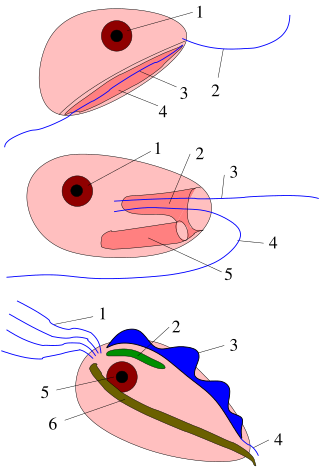
Excavata is an extensive and diverse but paraphyletic group of unicellular Eukaryota. The group was first suggested by Simpson and Patterson in 1999 and the name latinized and assigned a rank by Thomas Cavalier-Smith in 2002. It contains a variety of free-living and symbiotic protists, and includes some important parasites of humans such as Giardia and Trichomonas. Excavates were formerly considered to be included in the now obsolete Protista kingdom. They were distinguished from other lineages based on electron-microscopic information about how the cells are arranged. They are considered to be a basal flagellate lineage.

Giardia duodenalis, also known as Giardia intestinalis and Giardia lamblia, is a flagellated parasitic protozoan microorganism of the genus Giardia that colonizes the small intestine, causing a diarrheal condition known as giardiasis. The parasite attaches to the intestinal epithelium by an adhesive disc or sucker, and reproduces via binary fission. Giardiasis does not spread to other parts of the gastrointestinal tract, but remains confined to the lumen of the small intestine. The microorganism has an outer membrane that makes it possible to survive even when outside of its host, and which can render it tolerant to certain disinfectants. Giardia trophozoites are anaerobic, and absorb their nutrients from the intestinal lumen. If the organism is stained, its characteristic pattern resembles the familiar "smiley face" symbol.

Giardiasis is a parasitic disease caused by Giardia duodenalis. Infected individuals who experience symptoms may have diarrhoea, abdominal pain, and weight loss. Less common symptoms include vomiting and blood in the stool. Symptoms usually begin one to three weeks after exposure and, without treatment, may last two to six weeks or longer.

Trichomonas vaginalis is an anaerobic, flagellated protozoan parasite and the causative agent of a sexually transmitted disease called trichomoniasis. It is the most common pathogenic protozoan that infects humans in industrialized countries. Infection rates in men and women are similar but women are usually symptomatic, while infections in men are usually asymptomatic. Transmission usually occurs via direct, skin-to-skin contact with an infected individual, most often through vaginal intercourse. The WHO has estimated that 160 million cases of infection are acquired annually worldwide. The estimates for North America alone are between 5 and 8 million new infections each year, with an estimated rate of asymptomatic cases as high as 50%. Usually treatment consists of metronidazole and tinidazole.

The diplomonads are a group of flagellates, most of which are parasitic. They include Giardia duodenalis, which causes giardiasis in humans. They are placed among the metamonads, and appear to be particularly close relatives of the retortamonads.

The metamonads are a large group of flagellate amitochondriate microscopic eukaryotes. They include the retortamonads, diplomonads, parabasalids, oxymonads, and a range of more poorly studied taxa, most of which are free-living flagellates. All metamonads are anaerobic, and most members of the four groups listed above are symbiotes or parasites of animals, as is the case with Giardia lamblia which causes diarrhea in mammals.
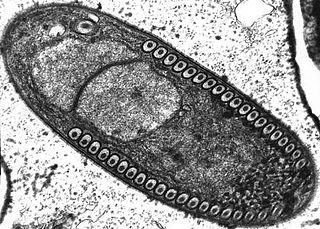
Microsporidia are a group of spore-forming unicellular parasites. These spores contain an extrusion apparatus that has a coiled polar tube ending in an anchoring disc at the apical part of the spore. They were once considered protozoans or protists, but are now known to be fungi, or a sister group to true fungi. These fungal microbes are obligate eukaryotic parasites that use a unique mechanism to infect host cells. They have recently been discovered in a 2017 Cornell study to infect Coleoptera on a large scale. So far, about 1500 of the probably more than one million species are named. Microsporidia are restricted to animal hosts, and all major groups of animals host microsporidia. Most infect insects, but they are also responsible for common diseases of crustaceans and fish. The named species of microsporidia usually infect one host species or a group of closely related taxa. Approximately 10 percent of the known species are parasites of vertebrates — several species, most of which are opportunistic, can infect humans, in whom they can cause microsporidiosis.
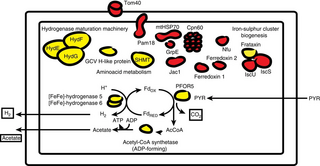
A hydrogenosome is a membrane-enclosed organelle found in some anaerobic ciliates, flagellates, and fungi. Hydrogenosomes are highly variable organelles that have presumably evolved from protomitochondria to produce molecular hydrogen and ATP in anaerobic conditions.
A mitosome is a mitochondrion-related organelle (MRO) found in a variety of parasitic unicellular eukaryotes, such as members of the supergroup Excavata. The mitosome was first discovered in 1999 in Entamoeba histolytica, an intestinal parasite of humans, and mitosomes have also been identified in several species of Microsporidia and in Giardia intestinalis.

Hexamita is a genus of parasitic diplomonads. It is related to Giardia. H. columbae and H. meleagridis live in the intestines of birds. H. muris and H. pitheci live in the intestines of mammals. H. salmonis and H. truttae live in the intestines of fish. Species in the Hexamita family are most commonly spread through fecal matter.
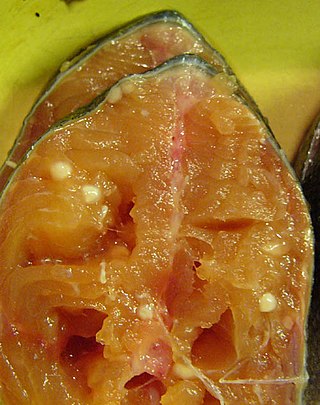
Henneguya zschokkei or Henneguya salminicola is a species of a myxosporean endoparasite. It afflicts several salmon in the genera Oncorhynchus and Salmo,where it causes milky flesh or tapioca disease. H. zschokkei is notable for its reliance on an exclusively anaerobic metabolism as well as its lack of mitochondria and mitochondrial DNA. It is the only known multicellular animal that does not require oxygen to survive.

Blastocystis is a genus of single-celled parasites belonging to the Stramenopiles that includes algae, diatoms, and water molds. There are several species, living in the gastrointestinal tracts of species as diverse as humans, farm animals, birds, rodents, reptiles, amphibians, fish, and cockroaches. Blastocystis has low host specificity, and many different species of Blastocystis can infect humans, and by current convention, any of these species would be identified as Blastocystis hominis.
The discovery of disease-causing pathogens is an important activity in the field of medical science. Many viruses, bacteria, protozoa, fungi, helminths, and prions are identified as a confirmed or potential pathogen. In the United States, a Centers for Disease Control and Prevention program, begun in 1995, identified over a hundred patients with life-threatening illnesses that were considered to be of an infectious cause but that could not be linked to a known pathogen. The association of pathogens with disease can be a complex and controversial process, in some cases requiring decades or even centuries to achieve.

Protozoan infections are parasitic diseases caused by organisms formerly classified in the kingdom Protozoa. These organisms are now classified in the supergroups Excavata, Amoebozoa, Harosa, and Archaeplastida. They are usually contracted by either an insect vector or by contact with an infected substance or surface.
Spironucleus salmonicida is a species of fish parasite. It is a flagellate adapted to micro-aerobic environments that causes systemic infections in salmonid fish. The species creates foul-smelling, pus-filled abscesses in muscles and internal organs of aquarium fish. In the late 1980s when the disease was first reported, it was believed to be caused by Spironucleus barkhanus. Anders Jørgensen was the person that found out what species really caused the disease.
Spironucleus is a diplomonad genus that is bilaterally symmetrical and can be found in various animal hosts. This genus is a binucleate flagellate, which is able to live in the anaerobic conditions of animal intestinal tracts. A characteristic of Spironucleus that is common to all metamonads is that it does not have aerobic mitochondria, but instead rely on hydrogenosomes to produce energy. Spironucleus has six anterior and two posterior flagella. The life cycle of Spironucleus involves one active trophozoite stage and one inactive cyst stage. Spironucleus undergoes asexual reproduction via longitudinal binary fission. Spironucleusvortens can cause lateral line erosion in freshwater anglefish. Spironucleuscolumbae is found to cause hexamitiasis in pigeons. Finally, Spironucleusmuris is found to cause illnesses of the digestive system in mice, rats, and hamsters. The genome of Spironucleus has been studied to exhibit the role of lateral gene transfer from prokaryotes in allowing for anaerobic metabolic processes in diplomonads.

Encephalitozoon cuniculi is a microsporidial parasite of mammals with world-wide distribution. An important cause of neurologic and renal disease in rabbits, E. cuniculi can also cause disease in immunocompromised people.
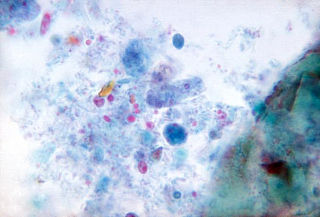
Dientamoeba fragilis is a species of single-celled excavates found in the gastrointestinal tract of some humans, pigs and gorillas. It causes gastrointestinal upset in some people, but not in others. It is an important cause of traveller's diarrhoea, chronic diarrhoea, fatigue and, in children, failure to thrive. Despite this, its role as a "commensal, pathobiont, or pathogen" is still debated. D. fragilis is one of the smaller parasites that are able to live in the human intestine. Dientamoeba fragilis cells are able to survive and move in fresh feces but are sensitive to aerobic environments. They dissociate when in contact or placed in saline, tap water or distilled water.
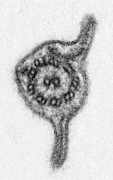
Chilomastix is a genus of pyriform excavates within the family Retortamonadidae All species within this genus are flagellated, structured with three flagella pointing anteriorly and a fourth contained within the feeding groove. Chilomastix also lacks Golgi apparatus and mitochondria but does possess a single nucleus. The genus parasitizes a wide range of vertebrate hosts, but is known to be typically non-pathogenic, and is therefore classified as harmless. The life cycle of Chilomastix lacks an intermediate host or vector. Chilomastix has a resistant cyst stage responsible for transmission and a trophozoite stage, which is recognized as the feeding stage. Chilomastix mesnili is one of the more studied species in this genus due to the fact it is a human parasite. Therefore, much of the information on this genus is based on what is known about this one species.

Mark van der Giezen is Professor of Biological Chemistry, Centre for Organelle Research, University of Stavanger, Norway. He holds Dutch nationality and is married with three children.















